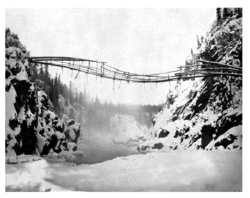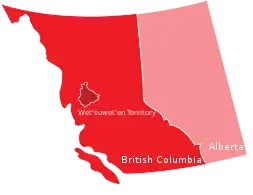Wetʼsuwetʼen
The Wetʼsuwetʼen[lower-alpha 1] (English: /wɛtˈsoʊɪtɪn/ ⓘ wet-SOH-ih-tin) are a First Nation who live on the Bulkley River and around Burns Lake, Broman Lake, and François Lake in the northwestern Central Interior of British Columbia. The endonym Wetʼsuwetʼen means "People of the Wa Dzun Kwuh River (Bulkley River)".[2]
 | |
| Total population | |
|---|---|
| approx. 3,160 (2019)[1] | |
| Regions with significant populations | |
| Canada (British Columbia) | |
| Languages | |
| English, Babine-Witsuwitʼen | |
| Religion | |
| traditional beliefs | |
| Related ethnic groups | |
| Other Dene peoples Especially Tsilhqotʼin, Dakelh, and Babine |


The Wetʼsuwetʼen are a branch of the Dakelh or Carrier people, and in combination with the Babine people have been referred to as the Western Carrier. They speak Witsuwitʼen, a dialect of the Babine-Witsuwitʼen language which, like its sister language Carrier, is a member of the Athabaskan family.
Their oral history, called kungax, recounts that their ancestral village, Dizkle or Dzilke, once stood upstream from the Bulkley Canyon.[3] This cluster of cedar houses on both sides of the river is said to have been abandoned because of an omen of impending disaster. The exact location of the village has been lost.[4] The neighbouring Gitxsan people of the Hazelton area have a similar tale, though the village in their version is named Dimlahamid (Temlahan).[5][6]
Clans
In the traditional Wetʼsuwetʼen governance system, there are five clans, which are further subdivided into thirteen house groups. Each house group is led by a single house chief, and also includes several sub chiefs (also referred to as "wing chiefs"). Hereditary chief names (both house chiefs and sub chiefs) are usually passed on to a successor chosen by the incumbent name holder, more often than not through family lines. Clan membership is transmitted matrilineally, from mother to children. In Witsuwit'en, male hereditary chiefs are referred to as dinï zeʼ, and female hereditary chiefs are referred to as tsʼakë zeʼ.[7]
The house groups and house chiefs of each of the five clans, as well as the English names of the current house chiefs, can be found in the chart below.
| House group | Translation | House chief name | Incumbent |
|---|---|---|---|
| Yex Tʼsa Witʼantʼ | Thin House | Goohlaht | vacant |
| Yex Tʼsa Wilkʼus | Dark House | Knedebeas | Warner William |
| Kayex | Birchbark House | Samooh | Herb Naziel |
| House group | Translation | House chief name | Incumbent |
|---|---|---|---|
| Kwen Beegh Yex | House Beside the Fire | Wah Tah Kwets | vacant |
| Gʼen Egh La Yex | House of Many Eyes | Hagwilnegh | Ron Mitchell |
| Tsee Kʼal Kʼe Yex | House on a Flat Rock | Wah Tah Kʼeght | vacant |
| House group | Translation | House chief name | Incumbent |
|---|---|---|---|
| Djakanyex | Beaver House | Kweese | vacant |
| Tsa Kʼen Yex | Rafters on Beaver House | Naʼmoks | John Ridsdale |
| House group | Translation | House chief name | Incumbent |
|---|---|---|---|
| Medzeyex | Owl House | Kloum Khun | Alphonse Gagnon |
| Tsalyex | Sun House | Smogelgem | Warner Naziel |
| House group | Translation | House chief name | Incumbent |
|---|---|---|---|
| Cassyex | Grizzly House | Woos | Frank Alec |
| Kalyexwenits | House in the Middle of Many | Gisdayʼwa | Fred Tom |
| Anaskasi | Where it Lies Blocking the Trail | Madeek | Jeff Brown |
*Unist'ot'en Camp Group is affiliated with the Yex T'sa Wilk'us (Dark House) under the Gilseyhu (Big Frog) Clan [8]
Wetʼsuwetʼen First Nation bands
History
In 1960, the Decker Lake, François Lake (later Nee-Tahi-Buhn), Maxim Lake and Skin Tyee Bands merged to form the Omineca Band. In 1984, the Omineca Band divided into the Nee-Tahi-Buhn and Browman (or Broman) Lake Bands, the latter of which later became Wetʼsuwetʼen First Nation. In 2000, the Skin Tyee Band separated from the Nee-Tahi-Buhn Band.[9]
Contemporary First Nation bands
The following two First Nations are members of the Carrier-Sekani Tribal Council:[10]
- Wetʼsuwetʼen First Nation - also known as Browman (or Broman) Lake, formerly as Browman Indian Lake Band, located outside of Burns Lake, British Columbia.[11]
- Ts'il Kaz Koh First Nation - also known as Burns Lake, located around Burns Lake, British Columbia.[12]
The following four First Nations are not affiliated with any tribal council:
- Hagwilget Village First Nation[13] - located in the village of Hagwilget (meaning "place of the gentle or quiet people" in Gitxsan),[14] also known as Tse-kya ("base of rock"), on the east side of the Bulkley Canyon, near Hazelton, British Columbia, about 325 kilometres inland from the coast.
- Nee-Tahi-Buhn Band - formerly called François Lake Tribe. Nee-Tahi-Buhn is the Babine-Witsuwitʼen name for François Lake, and means "it fills at one end and empties at the other".
- Skin Tyee First Nation - also known as the Skin Tyee Indian Band, also spelled "Skin Tayi", located near François Lake, in the Omineca Country to the west of the City of Prince George, British Columbia.[15]
- Witset First Nation[16] - also known as Moricetown Band, located in Witset, British Columbia.[17]
Office of the Wetʼsuwetʼen
The Office of the Hereditary Chiefs of the Wetʼsuwetʼen, also known as the Office of the Wetʼsuwetʼen or the OW, is a political organization governed by the hereditary chiefs of the Wetʼsuwetʼen people, based in Smithers, British Columbia. The Office takes part in the BC Treaty Process through the two Indian Act band governments (Hagwilget and Witset First Nations) which contain the 13 hereditary chieftaincies. The Office is not a tribal council, nor a traditional governing body, but rather a non-profit society,[18] directed by a Board of Directors, with the goal of being a central office of the Wetʼsuwetʼen Nation. It was founded as an independent office in 1994, after the splitting of the Gitxsan-Wet’suwet’en Tribal Council, which had represented the two nations during Delgamuukw v British Columbia.[19][20]
As of April 2020, the Board of Directors was composed of seven house chiefs (Naʼmoks, Knedebeas, Madeek, Samooh, Kloum Khun, Wah Tah Kʼeght, and Hagwilnegh).[21]
As of 2009, the organization was at Stage 4 of the BC Treaty Process.
On May 14, 2020, the governments of Canada and British Columbia signed a Memorandum of Understanding (MOU) with the hereditary chiefs of the Wet’suwet’en, in which the Canadian and B.C. governments "recognize that Wet’suwet’en rights and title are held by Wet’suwet’en houses under their system of governance".[22] Following concerns by leaders of the band councils, the hereditary chiefs clarified that the Office of the Wetʼsuwetʼen is not a governing body, and that the authority of the band councils under the MOU would not be diminished.[18]
See also
Notes
- Witsuwitʼen is the correct spelling in the writing system in general use. In non-technical publications it is usually misspelled as Witsʼuwitʼen, Witʼsuwitʼen, Wetsʼuwetʼen, or Wetʼsuwetʼen due to the difficulty of distinguishing ejective [ts] from plain [ts]. Official spellings with <tʼs> are used in the names of the Wetʼsuwetʼen First Nation and the Office of the Wetʼsuwetʼen. In point of fact the [ts] is not ejective. Older spellings include Hotsotʼen and Hwotsotʼen. Whutsowhutʼen is the Carrier name in the Carrier Linguistic Committee writing system in general use for that language.
References
Citations
- "Wet'suwet'en Hereditary Chiefs | BC Treaty Commission". www.bctreaty.ca.
- "A History of the Wetʼsuwetʼen Village of Tse-kya".
- Mills 2011, p. 77.
- See also Rocher Déboulé Range.
- Glavin, Terry. Death Feast at Dimlahamid.
- Barbeau, Marius. The Downfall of Temlahan.
- "Wetʼsuwetʼen Hereditary Chiefs Set the Record Straight in Response to Province of BC's Divide and Conquer Sharp Dealings" (PDF) (Press release). June 15, 2016.
- "Governance Structure".
- "Nee Tahi Buhn". Office of the Wetʼsuwetʼen. Retrieved June 6, 2020.
- "Cstc.bc.ca". www.cstc.bc.ca.
- "Browman Lake". Office of the Wetʼsuwetʼen. Retrieved March 12, 2020.
- "Ts'il Kaz Koh (Burns Lake)". British Columbia Assembly of First Nations. Retrieved June 6, 2020.
- "About | Hagwilget". Hagwilget Village Co.
- "Investing with Hagwilget Village Council". British Columbia. Retrieved March 12, 2020.
- "Skin Tyee". Office of the Wetʼsuwetʼen. Retrieved March 12, 2020.
- "Witset First Nation | Moricetown Band Office | Tourism Witset". Witset Band Office.
- "Moricetown". Office of the Wetʼsuwetʼen. Retrieved March 12, 2020.
- Wet’suwet’en Hereditary Chiefs (May 11, 2020). "Re: MOU Meetings with Wet'suwet'en Clans and elected Chief and Band Councillors" (PDF). Letter to Chief Maureen Luggi.
- Forester, Brett (March 10, 2020). "The Delgamuukw decision: When the 'invisible people' won recognition". APTN National News. Retrieved June 6, 2020.
- "About Our Organization". Office of the Wetʼsuwetʼen. Retrieved June 6, 2020.
- "Office of the Wet'suwet'en Board of Directors". Office of the Wetʼsuwetʼen. Archived from the original on April 17, 2020. Retrieved June 6, 2020.
- "Memorandum of Understanding Between Canada, British Columbia and Wetʼsuwetʼen As agreed on February 29, 2020" (PDF) (Press release). May 14, 2020.
Sources
- Mills, Antonia (2011). Eagle Down Is Our Law: Witsuwit'en Law, Feasts, and Land Claims. Vancouver: UBC Press. ISBN 0774805137.